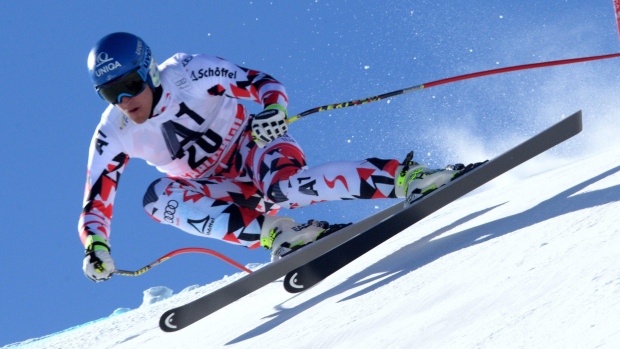Feb 21, 2015
Mayer leads Austrian sweep in World Cup downhill
Olympic champion Matthias Mayer led an Austrian sweep of the podium in a World Cup downhill on home snow Saturday. Mayer clocked 1 minute, 49.83 seconds down the rarely used Schneekristall-Zwolfer course to finish a slim 0.02 seconds ahead of Max Franz.
The Canadian Press

SAALBACH-HINTERGLEMM, Austria - In the space of two weeks, the Austrian downhill skiing team has gone from "historic disaster" to a clean sweep of a podium.
Olympic champion Matthias Mayer led an Austrian 1-2-3 finish in a World Cup on home snow on Saturday, marking the first such sweep in nine years for the once dominant "Wunderteam."
The feat came exactly 14 days after an Austrian failed to place in the top 10 of the men's downhill at the world championships in Colorado for the first time in the event — stretching back to 1931.
"We had a historic disaster in Beaver Creek and it's a little revenge," Austria winter sports federation president Peter Schroecksnadel said. "That's ski sport. If it wouldn't be that (way) it wouldn't be interesting."
Down the rarely used Schneekristall-Zwolfer course, Mayer finished 0.02 seconds ahead of Max Franz, who led both training runs. Hannes Reichelt placed third, 0.21 behind.
It was the first Austrian sweep of a men's downhill since January 2006, when Hermann Maier, Klaus Kroell and Andreas Buder went 1-2-3 in Garmisch-Partenkirchen, Germany.
"This success is important for the entire nation and staff," said Reichelt, who won the super-G at the worlds.
It was Mayer's second career World Cup win, having also taken a downhill at the finals last March in Lenzerheide, Switzerland — a month after his surprise win at the Sochi Games.
"I had quite a fight but it was really cool," said Mayer, the highest-placed Austrian at 12th in the worlds downhill. "The visibility was brutal."
After two days of sun for the training runs, clouds moved in and visibility was difficult, leading to 12 racers failing to finish. Skiers expressed concern over the course's safety during training, and workers smoothed over a few areas for race day.
The last men's downhill on this course was in 1994, making it an entirely new piste for all of the current racers.
Austria, Norway and Germany trained on the course last week. While Mayer missed those sessions, it was obvious that his teammates benefited.
"It's not surprising. (The Austrians) trained here before and that's a big advantage," said downhill standings leader Kjetil Jansrud of Norway, who finished 14th. "I got to train here, too, so I should probably be up there, too. But no one ever doubted they were good skiers. I'm not surprised they're back in the lead."
Schroecksnadel defended the Austrians' extra training.
"Every nation does this," Schroecksnadel said. "It might have been a little advantage but you still have to race."
Rules permit racers to test the course up to five days before the opening training session. But since none of the current skiers had ever raced on this course, extra training proved to be even more of an advantage than usual.
With Vincent Kriechmayr skiing from bib No. 40 into sixth and Romed Baumann 10th, Austrians claimed five of the top 10 positions.
Former overall champion Carlo Janka of Switzerland was fourth.
Struggling a day after chipping his tooth in a ragged training run, Jansrud still extended his lead in the downhill standings ahead of Italy's Dominik Paris, who didn't finish.
"I felt pretty good but it's a mental game," Jansrud said. "You know, you had a bad training run, and when it gets dark with flat light you don't see any of the ruts. I tried to ski through them but didn't manage to put down a good run.
"It's tough to convince yourself you can see when you can't."
Jansrud remained second in the overall standings, 162 points behind Austrian technical specialist Marcel Hirscher, who does not race downhill.
Saalbach also hosted the 1991 world championships and is hoping to be Austria's choice in a bid for the 2021 or 2023 worlds, with St. Anton the other option.
___
Andrew Dampf can be followed at www.twitter.com/asdampf
